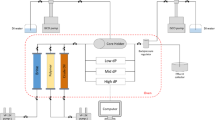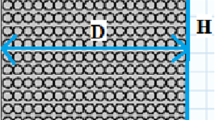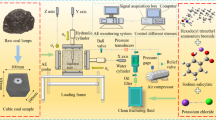Abstract
Compressed air energy storage (CAES) technology has been re-emerging as a viable energy storage option to address challenges coming from the mismatch between renewable energy sources and energy demands. Various geologic formations, such as hard rock caverns, depleted oil/gas reservoirs, and saline aquifers, have been considered as the alternative of salt dome caverns for CAES. Storing compressed air in either depleted oil/gas reservoirs or saline aquifers involves two-phase fluid flow in porous media. Moreover, the drainage-imbibition process is likely to be repeated numerous cycles during the CAES operation. In this regard, a thorough understanding of the two-phase fluid flow during the cyclic injection and withdrawal of compressed air is critical to predict the performance of CAES in porous media and to improve its efficiency. This study investigates the repetitive two-phase fluid (water/oil) flow using polydimethylsiloxane-based pore-network micromodels. Two different geometries, Type I with circular solids and Type II with square solids were prepared to represent an unconsolidated and/or partially consolidated sandstone and a fracture network of carbonate rock. During repetitive drainage-imbibition cycles, it was observed that the occupation efficiency of the non-wetting fluid (water) converged to a narrow range for Type I model, while it showed a pronounced fluctuation for Type II, which was partly due to the low residual saturation of the non-wetting fluid during the imbibition process. Besides, the prevalent displacement modes of wetting and non-wetting fluids at the pore-scale were noticeably different between the two pore structures, which were manifested in the unpredictable pattern of non-wetting fluid flow for Type II over the extended cycles. Sweep efficiency and residual saturation in Type I were greater than those in Type II; however, an analysis of effective sweep efficiency and effective residual saturation yielded an opposite result. It implies that the actual efficiency of non-wetting fluid invasion is higher in Type II, and the Type II geometry can accommodate more non-wetting fluid in a given reservoir volume during the charge period. Moreover, more non-wetting fluid can be discharged back for energy regeneration. In conclusion, the geometry of porous media has a great influence on the efficiency of repetitive drainage-imbibition cycles of two-phase fluid flow in porous media, and thus more elaborate study is needed to gain the confidence on the cyclic efficiency of CAES in porous media.












Similar content being viewed by others
References
Allen, R.D., Doherty, T.J., Erikson, R.L., Wiles, L.E. (1983) Factors affecting storage of compressed air in porous rock reservoirs. Technical report PNL-4707, Pacific Northwest Laboratory
Allen, R.D., Doherty, T.J., Istvan, J.A., Pereira, J.C., Schainker, R.B. (1984) Preliminary results from the pittsfield aquifer field test applicable to commercialization of compressed air energy storage technology. In: Intersociety Energy Conversion Engineering Conference, San Francisco, USA, pp. 1081–1090
Andrew, M., Bijeljic, B., Blunt, M.J.: Pore-by-pore capillary pressure measurements using X-ray microtomography at reservoir conditions: curvature, snap-off, and remobilization of redidual CO2. Water Resour. Res. 50(11), 8760–8774 (2014). https://doi.org/10.1002/2014WR015970
Avraam, D.G., Payatakes, A.C.: Flow regimes and relative permeabilities during steady-state two-phase flow in porous media. J. Fluid Mech. 293, 207–236 (1995). https://doi.org/10.1017/S0022112095001698
Bazylak, A., Berejnov, V., Markicevic, B., Sinton, D., Djilali, N., Columbia, B. (2008) A microfluidic pore network approach to investigate water transport in fuel cell porous transport layers. In: Proceedings of the Sixth International ASME Conference on Nanochannels, Microchannels and Minichannels, ICNMM 2008-62349, Darmstadt, Germany
Bear, J.: Dynamics of Fluids in Porous Media. Dover, New York (1988)
Berejnov, V., Djilali, N., Sinton, D.: Lab-on-chip methodologies for the study of transport in porous media: energy applications. Lab Chip 8(5), 689–693 (2008). https://doi.org/10.1039/B802373P
Bos, C.F.M.: Underground storage and sequestration. In: Wong, ThE, Batjes, D.A.J., De Jager, J. (eds.) Geology of the Netherlands, pp. 335–340. Royal Netherlands Academy of Arts and Sciences, Amsterdam (2007)
Bowker, H.A., Lieberman, G.J.: Engineering Statistics, 1st edn. Prentice-Hall, Englewood Cliffs (1959)
Bui, H.V., Herzog, R.A., Jacewice, D.M., Lange, G.R., Scarpace, E.R., Thomas, H.H. (1990) Compressed-air energy storage: Pittsfield aquifer field test. EPRI Report-GS-6688
Chatzis, I., Morrow, N.R., Lim, H.T.: Magnitude and detailed structure of residual oil saturation. Soc. Petrol. Eng. J. 23(02), 311–326 (1983). https://doi.org/10.2118/10681-PA
Cottin, C., Bodiguel, H., Colin, A.: Drainage in two-dimensional porous media: from capillary fingering to viscous flow. Phys. Rev. E 82(4), 046315 (2010). https://doi.org/10.1103/PhysRevE.82.046315
Cottin, C., Bodiguel, H., Colin, A.: Influence of wetting conditions on drainage in porous media: a microfluidic study. Phys. Rev. E 84(2), 026311 (2011). https://doi.org/10.1103/PhysRevE.84.026311
Delamarche, E., Schmid, H., Michel, B., Biebuyck, H.: Stability of molded polydimethylsiloxane microstructures. Adv. Mater. 9(9), 741–746 (1997). https://doi.org/10.1002/adma.19970090914
Fernandes, J.S., Appoloni, C.R., Fernandes, C.P.: Determination of the representative elementary volume for the study of sandstones and siltstones by X-ray microtomography. Mater. Res. 15(4), 662–670 (2012). https://doi.org/10.1590/s1516-14392012005000081
Follesø, H.N. (2012) Fluid displacements during multiphase flow visualized at the pore scale using micromodels. Master thesis, University of Bergen, Norway
Gao, Y., Yao, J., Yang, Y., Zhao, J. (2014) REV Identification of tight sandstone in sulige gas field in Changqing oilfield China using CT based digital core technology. In: International Symposium of the Society of Core Analysis, Avignon, France
Gardner, W.P. (2013) Preliminary formation analysis for compressed air energy storage in depleted natural gas reservoirs. Sandia report 2013-4323, Sandia National Laboratories
Guo, C., Zhang, K., Li, C., Wang, X.: Modelling studies for influence factors of gas bubble in compressed air energy storage in aquifers. Energy 107, 48–59 (2016). https://doi.org/10.1016/j.energy.2016.04.003
Guo, C., Zhang, K., Pan, L., Cai, Z., Li, C., Li, Y.: Numerical investigation of a joint approach to thermal energy storage and compressed air energy storage in aquifers. Appl. Energy 203, 948–958 (2017). https://doi.org/10.1016/j.apenergy.2017.06.030
Haines, W.B.: Studies in the physical properties of soil. V. The hysteresis effect in capillary properties, and the modes of moisture distribution associated therewith. J. Agric. Sci. 20(1), 97–116 (1930)
Jambayev, A.S. (2013) Discrete fracture network modeling for a carbonate reservoir. Doctoral dissertation, Colorado School of Mines, USA
Kabuth, A., Dahmke, A., Beyer, C., Bilke, L., Dethlefsen, F., Dietrich, P., Duttmann, R., Ebert, M., Feeser, V., Görke, U.J., Köber, R., Rabbel, W., Schanz, T., Schäfer, D., Würdemann, H., Bauer, S.: Energy storage in the geological subsurface: dimensioning, risk analysis and spatial planning: the ANGUS + project. Environ. Earth Sci. 76, 23 (2017). https://doi.org/10.1007/s12665-016-6319-5
Kushnir, R., Ullmann, A., Dayan, A.: Compressed air flow within aquifer reservoirs of CAES plants. Transp. Porous Media 81, 219–240 (2010). https://doi.org/10.1007/s11242-009-9397-y
Kushnir, R., Ullmann, A., Dayan, A.: Thermodynamic and hydrodynamic response of compressed air energy storage reservoirs: a review. Rev. Chem. Eng. 28(2–3), 123–148 (2012). https://doi.org/10.1515/revce-2012-0006
Lenormand, R.: Liquids in porous media. J. Phys.: Condens. Matter 2(1), 79–88 (1990). https://doi.org/10.1088/0953-8984/2/S/008
Lenormand, R., Zarcone, C. (1984) Role of roughness and edges during imbibition in square capillaries. In: SPE Annual Technical Conference and Exhibition, Houston, USA. https://doi.org/10.2118/13264-MS
Lenormand, R., Touboul, E., Zarcone, C.: Numerical models and experiments on immiscible displacements in porous media. J. Fluid Mech. 189, 165–187 (1988). https://doi.org/10.1017/S0022112088000953
Lenormand, R., Zarcone, C., Sarr, A.: Mechanisms of the displacement of one fluid by another in a network of capillary ducts. J. Fluid Mech. 135, 337–353 (1983). https://doi.org/10.1017/S0022112083003110
Liu, Z., Herring, A., Arns, C., Berg, S., Armstrong, R.T.: Pore-scale characterization of two-phase flow using integral geometry. Transp. Porous Media 118(1), 99–117 (2017). https://doi.org/10.1007/s11242-017-0849-5
Luo, X., Wang, J., Dooner, M., Clarke, J., Krupke, C.: Overview of current development in compressed air energy storage technology. Energy Procedia 62, 603–611 (2014). https://doi.org/10.1016/j.egypro.2014.12.423
McGrail, B., Davidson, C., Bacon, D., Chamness, M., Reidel, S., Spane, F., Cabe, J., Knudsen, F., Bearden, M., Horner, J., Schaef, H., Thorne, P. (2013) Techno-economic performance evaluation of compressed air energy storage in the Pacific Northwest, technical report PNNL-22235, Pacific Northwest National Laboratory
Morini, G.L.: Laminar-to-turbulent flow transition in microchannels. Microscale Thermophys. Eng. 8, 15–30 (2004). https://doi.org/10.1080/10893950490272902
Murshed, S.M.S., Tan, S.H., Nguyen, N.T.: Temperature dependence of interfacial properties and viscosity of nanofluids for droplet-based microfluidics. J. Phys. D Appl. Phys. 41, 085502 (2008). https://doi.org/10.1088/0022-3727/41/8/085502
Muskat, M., Wycokoff, R.D.: An approximate theory of water-coning in oil production. Trans. AIME 114(1), 144–163 (1935). https://doi.org/10.2118/935144-G
Nelson, P.H.: Pore-throat sizes in sandstones, tight sandstones, and shales. AAPG Bull. 93(3), 329–340 (2009). https://doi.org/10.1306/10240808059
Oldenburg, C.M., Pan, L.: Porous media compressed-air energy storage (PM-CAES): theory and simulation of the coupled wellbore-reservoir system. Transp. Porous Media 97(2), 201–221 (2013). https://doi.org/10.1007/s11242-012-0118-6
Peters, E.J.: Advanced Petrophysics: Dispersion, Interfacial Phenomena, vol. 2. Greenleaf Book Group, Austin (2012)
Rogers, A., Henderson, A., Wang, X., Negnevitsky, M. (2014) Compressed air energy storage: thermodynamic and economic review. In: IEEE Power and Energy Society General Meeting. Maryland, USA. https://doi.org/10.1109/PESGM.2014.6939098
Soleimani, M.: Naturally fractured hydrocarbon reservoir simulation by elastic fracture modeling. Pet. Sci. 14(2), 286–301 (2017). https://doi.org/10.1007/s12182-017-0162-5
Stankovich, J.M., Lockington, D.A.: Brooks-Corey and van Genuchten soil–water-retention models. J. Irrig. Drain. Eng. 121(1), 1–7 (1995). https://doi.org/10.1061/(asce)0733-9437(1995)121:1(1)
Sternberg, A., Bardow, A.: Power-to-what?—environmental assessment of energy storage systems. Energy Environ. Sci. 8(2), 389–400 (2015). https://doi.org/10.1039/C4EE03051F
Succar, S., Williams, R.H. (2008) Compressed air energy storage : theory, resources, and applications for wind power, technical report NRC000040, Princeton Environmental Institute, Princeton University
Tang, S.K., Whitesides, G.M.: Basic microfluidic and soft lithographic techniques. In: Fainman, Y., Psaltis, D., Yang, C. (eds.) Optofluidics: fundamentals, devices, and applications, pp. 7–32. McGraw-Hill, New York (2010)
van Genuchten, M.T.: A closed-form equation for predicting the hydraulic conductivity of unsaturated soils. Soil Sci. Soc. Am. J. 44(5), 892–898 (1980). https://doi.org/10.2136/sssaj1980.03615995004400050002x
Venkataramani, G., Parankusam, P., Ramalingam, V., Wang, J.: A review on compressed air energy storage—a pathway for smart grid and polygeneration. Renew. Sustain. Energy Rev. 62, 895–907 (2016). https://doi.org/10.1016/j.rser.2016.05.002
Vizika, O., Payatakes, A.C.: Parametric experimental study of forced imbibition in porous media. Physicochem. Hydrodyn. 11(2), 187–204 (1989)
Wang, B., Bauer, S.: Compressed air energy storage in porous formations: a feasibility and deliverability study. Pet. Geosci. 23(3), 206–314 (2017). https://doi.org/10.1144/petgeo2016-049
Warren, J.E., Root, P.J.: The behavior of naturally fractured reservoirs. Soc. Petrol. Eng. J. 3(3), 245–255 (1963). https://doi.org/10.2118/426-PA
Wiles, L.E. (1979) Numerical analysis of temperature and flow effects in a dry two-dimensional porous-media reservoir used for compressed air energy storage, technical report PNL-3047, Pacific Northwest Laboratory
Wiles, L.E., Mccann, R.A. (1981) Water coning in porous media reservoirs for compressed air energy storage, technical report PNL-3470, Pacific Northwest Laboratory
Xia, Y., Whitesides, G.M.G.: Soft lithography. Angew. Chem. 37(5), 550–575 (1998). https://doi.org/10.1002/(SICI)1521-3773(19980316)37:5%3c550:AID-ANIE550%3e3.0.CO;2-G
Xu, W., Ok, J.T., Xiao, F., Neeves, K.B.: Effect of pore geometry and interfacial tension on water–oil displacement efficiency in oil–wet microfluidic porous media analogs. Phys. Fluids 26, 093102 (2014). https://doi.org/10.1063/1.4894071
Zacharoudiou, I., Boek, E.S.: Capillary filling and Haines jump dynamics using free energy Lattice Boltzmann simulations. Adv. Water Resour. 92, 43–56 (2016). https://doi.org/10.1016/j.advwatres.2016.03.013
Zakirov, T.R., Galeev, A.A., Korolev, E.A., Statsenko, E.O.: Flow properties of sandstone and carbonate rocks by X-ray computed tomography. Curr. Sci. 110(11), 2142–2148 (2016). https://doi.org/10.18520/cs/v110/i11/2142-2148
Zheng, X., Mahabadi, N., Sup Yun, T., Jang, J.: Effect of capillary and viscous force on CO2 saturation and invasion pattern in the microfluidic chip. J. Geophys. Res. Solid Earth 122, 1634–1647 (2017). https://doi.org/10.1002/2016JB013908
Acknowledgements
This research was supported by the Research Council: Interdisciplinary Grant at University of Nebraska-Lincoln (Grant No. 26-1107-9001-014) for S. Kim and S. Ryu, the Start-up Grant for S. Kim at University of Nebraska-Lincoln, and American Chemical Society Petroleum Research Fund for S. Ryu. We appreciate Stephen Morin for his assist in microfluidics master mold fabrication.
Author information
Authors and Affiliations
Corresponding author
Additional information
Publisher's Note
Springer Nature remains neutral with regard to jurisdictional claims in published maps and institutional affiliations.
Rights and permissions
About this article
Cite this article
Zhang, J., Zhang, H., Lee, D. et al. Microfluidic Study on the Two-Phase Fluid Flow in Porous Media During Repetitive Drainage-Imbibition Cycles and Implications to the CAES Operation. Transp Porous Med 131, 449–472 (2020). https://doi.org/10.1007/s11242-019-01353-4
Received:
Accepted:
Published:
Issue Date:
DOI: https://doi.org/10.1007/s11242-019-01353-4




